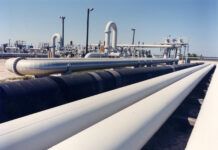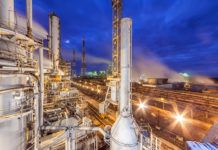Sometimes too much is just too much. While the supply glut in natural gas, ethylene and oil ultimately provides cheaper feedstocks for the petrochemical industry and positions the U.S. as the global supplier of choice, it also signals demand-side problems.
Of course, this has been exacerbated exponentially by the Covid-19 pandemic, as worldwide demand for all fuels fell dramatically due to stay-at-home orders, lockdowns and temporarily shuttered plants.
It’s a complex dynamic that plays out in rather visible and tragic ways in the Permian Basin. The associated natural gas coming out of oil wells there is being flared in unprecedented volumes, as it has nowhere to go. That’s because incomprehensively low gas prices make it difficult to justify the expense of getting the product out. This likely will continue through 2020 to an extent, despite furloughs and spending cuts caused by the pandemic and a Russian-Saudi price war.
A similar price dynamic holds true for ethylene. U.S. spot ethylene prices continued their decline into 2020, due to a fundamental oversupply in the market and lagging demand. To find an outlet, U.S. ethylene producers have turned to export terminals, such as Enterprise and Navigator Holdings’ new 1 million-ton-per-year facility in Morgan’s Point, Texas.
Short-term variables aside, many industrial owners are bullish about ethylene’s long-term prospects. Formosa Plastics—through its subsidiary FG LA LLC—plans to move forward with its new $9.4 billion St. James Parish mega plant despite short-term demand problems. Janile Parks, director of community and government relations for FG LA LLC, says in a written statement that preliminary work has already begun, but admits there is a good deal of market uncertainty. “We will monitor the developments closely and adjust our planning accordingly,” Parks says in the statement.
“While the price of ethylene has dropped,” she adds, “the cost of raw materials has also lowered due to development in the shale gas market; therefore, the project phases remain unchanged at this point.”
Dubbed the Sunshine Project, the Formosa facility will produce polyethylene, polypropylene and ethylene glycol products to be sold to domestic and international markets. The owner currently plans to construct the plant in two phases from 2021-2029.
There is reason for Formosa’s optimism. According to a study by Grand View Research, domestic demand for plastic products is expected to rise over the next decade, and global demand by about 3% to 4% per year. “These studies demonstrate current and increasing market demand that the project will help to meet,” Parks says.
Trey Hamblet, vice president of chemicals research for Industrial Info Resources in Houston, says even though commodity ethylene prices are “at the floor,” he feels that most of the proposed ethylene projects will come to fruition. “Do they become a reality in the timeframe they’re currently proposed? Probably not,” Hamblet says. “We might be in an oversupply position at the moment, but if you look at consumption around the world, China is still growing, southeast Asia is still growing and the demand for polyethylene, polypropylene, ethylene, methanol, ammonia, etc. are still significant in the long-term.
“And we are the cheapest place on planet Earth to produce them.”
He also expects the new Enterprise terminal to be joined by an additional three to four terminals in the next five years as the commercial export of large-scale quantities of ethylene expands. “I think that will help the long-term fundamentals because ethylene becomes an export commodity in a global market,” he adds. “We can compete around the world for those people that are producing ethylene from naphtha or methanol or other feedstocks.
“I think all the big players are thinking we’ll be locked into this incredibly cheap access to feedstock for so long that it supports that long-term play, perhaps into the 2030s.”
Roughly 60% of the ethylene produced in the U.S. goes into manufacturing polyethylene, “and I think that percentage of consumption is indicative of the rest of the world,” Hamblet says.
TEXAS IS BURNING
Meanwhile, there’s so much natural gas coming out of the Permian that gas processing facilities in the region can’t handle it all. Improved drilling efficiencies and cost reductions, higher associated gas production from oil rigs and production growth are to blame, as they’re outpacing a rise in domestic demand and exports. The natural gas spot price at Henry Hub was expected to average $2.33 per MMBtu in 2020 even before Covid-19’s impacts. That’s 24 cents lower than the 2019 average of $2.57 per MMBtu.
That’s not likely to change anytime soon. In its 2020 Short Term Energy Outlook, the U.S. Energy Information Agency projects average U.S. natural gas prices will be 9 percent lower in 2020.
Subsequently, flaring has become a source of negative attention for Permian oil producers, and Texas regulators have come under pressure from environmentalists and politicians to do something about it. Rystad, a provider of flaring and venting data, estimates that Permian producers burned off or released about 190 million cubic feet per day of natural gas in 2019. The company gets its information from the U.S. Environmental Protection Agency and the Texas Railroad Commission, which regulate oil and gas in the state.

Eric Smith, associate director of the Tulane Energy Institute, points to an unfortunate lack of foresight as the culprit. “It’s a sad scenario in West Texas,” Smith says. “This is perfectly good natural gas, but it’s being flared. The price is so low that there’s no incentive for them to do anything else.”
The expense of processing the gas for transport, in accordance with federal regulations, sets the bar too high. At the end of the day, transporting the oil—not gas—out of the Permian is significantly more profitable. “After the gas is separated from the oil, they’ve also got to take out the C3s and C4s and propane and butane and some of the ethane to comply with federal guidelines,” he adds. “That makes it too expensive to ship.”
To change the current dynamic, Smith says the state regulatory bodies need to impose stricter guidelines for issuing flaring exemptions. “I think it’s politically indefensible,” he adds. “At the end of the day it (flaring) is not a good idea.”
Loren Scott, an economist at Loren C. Scott & Associates in Baton Rouge, says the problem isn’t likely to end soon, as many of the Permian wells are in their fourth and fifth years of production and are therefore producing more natural gas than oil. Additionally, increased fracking in the Permian, Bakken and Marcellus shale plays will likely keep the prices depressed for the next four to five years.
In addition to the Covid-19 pandemic, some other short-term reasons for the price problem exist. “We had an unusually warm winter,” Scott says. “The weather phenomena that we’re experiencing right now has decreased the amount of heating that is required and decreased the demand for natural gas by billions of cubic feet. That’s causing supplies to build up in storage and the price to go down.

“On the supply side we’ve just got an ocean of natural gas.”
One silver lining … there’ll be no flaring in the Haynesville Shale Play, as it is strictly a dry gas play. There is also a very specific need for the natural gas being produced there, chiefly the burgeoning LNG market in southwest Louisiana. “We drill for that gas on purpose,” Tulane’s Smith says. “You’ve got to take the water out and do some treatments, but it’s basically pipeline quality gas.”
Also, the EIA expects growth in consumption in the U.S. industrial sector in 2021, driven by new methanol plants using natural gas as feedstock.
HAYNESVILLE RISING
Greg Upton, assistant professor of research at LSU’s Center for Energy Studies, says the Haynesville Shale play is surprisingly competitive right now, even with low gas prices.
The advent of new fracking technologies is playing an undeniable role, as fewer rigs are needed to produce the same amount of gas.

That explains why rig counts in the Haynesville Shale have dropped from 140 to about 30, while production increased by some 28% in 2017 and 2018. “If you look strictly at the rig counts, that’s not really indicative of what’s going on,” Upton says. “It’s because of improving technology; they’re able to do more with less. There are even some expired leases that they’re actually re-leasing now.”
Tyler Gray, president and general counsel of Louisiana Mid-Continent Oil & Gas Association, says improved efficiencies at the wellhead are enabling Haynesville producers to do more from one location. “That’s due to a multitude of factors, such as the way that they drill it, the length of the laterals etc.,” Gray says. “It’s not like the old days when you’d just poke holes in the ground. They know exactly where the gas is. They’re not just out there drilling exploratory wells to see what the geology looks like.”
There’s also increasing demand for the gas due to rising LNG demand in southwest Louisiana and the potential of long-term contracts. “If you’ve got a long-term contract to produce gas to export, through LNG or some other plant, then you could, in theory, continue to produce no matter how low the prices go,” Upton says.
Scott agrees. “Haynesville’s salvation is that it’s geographically closer to the Lake Charles LNG facilities than the Permian Basin.”
DEMAND CHANGES EVERYTHING
If anything is going to change the oversupply issue, it’s going to be on the demand side of the equation. Long-term, much of that will likely come from an explosion in LNG investment along the Gulf Coast, as well as billions of dollars in new industrial cat cracker investment.
LNG capacity coming online virtually ensures an eventual drawdown of supply, Smith says. “These things (oversupply) tend to be self-correcting. The price will go up, and everybody’s a lot happier. They won’t be interested in flaring gas when they can buy it for $3 to $4.”
Meanwhile, there are thousands of drilled but incomplete wells in the Permian simply waiting for a market upturn. “It costs almost as much to frack the well as it does to drill it,” he adds. “So what they’ve done is drill, but not complete, a lot of wells. When the price goes up a little bit they’ll make a decision whether or not to frack the well and put it online.”
However, if global demand goes flat, the entire value chain will be disrupted. There are some very real concerns in that regard. When the trade war began, Louisiana’s exports to China dropped precipitously. “If you don’t have that demand source at the end of the value chain, that hurts everyone,” LSU’s Upton says. “You don’t have customers.”
“So the question is not whether we have the product, the question is when we build the infrastructure to export the product, will the export demand be there?”
Mark Finley, an energy and global oil expert at Rice University’s Baker Institute for Public Policy in Houston, says a drop in demand poses the biggest threat, as the supply side is firmly under domestic control. Taking a long-term view, Finley says electric cars and an increasing environmental awareness could also lead to a paradigm shift in global market demand. If that happens, all bets are off. “There are also some short-term threats,” he adds, “such as a global economic slowdown, or more recently a virus, that could have dire consequences.”
Through it all, the LNG market has not been immune. They’ve also experienced some recent “flies in the ointment,” namely Covid-19 and delayed contracts. India’s Petronet LNG recently delayed a final agreement to buy up to 5 million tons per year of LNG from Tellurian’s proposed Driftwood LNG production and export terminal on the west bank of the Calcasieu River. In a recent announcement, Tellurian said it had extended its Memorandum of Understanding with Petronet to May 31 to allow additional time for Petronet’s consultative review process. Tellurian originally expected to finalize the agreement by the end of March.
The negotiations involve not just the purchase of LNG but also an equity investment in Driftwood Holdings. India’s demand for LNG has risen 27 percent year over year, and Modi plans $60 billion of investments in natural gas infrastructure for the company.
Still, other owners maintain their optimism about the long-term prospects of LNG. Speaking at a recent Louisiana industry event, Frederic Phipps, president of Shell U.S. LNG, says the long-term demand remains strong—despite recent trepidation over Covid-19and other market factors—as gas continues to be the fuel of choice for cleaner energy solutions. Shell and Energy Transfer have partnered to build Lake Charles LNG, although they recently delayed the project to 2025.
Despite the delay, Phipps says the record supply of domestic natural gas has buoyed LNG prospects locally. “A growing population and rising living standards will continue to drive the demand for energy with lower emissions.”
Elsewhere, Cameron LNG is close to reaching the final stages of constructing its three-train LNG facility in Hackberry. Cameron LNG, a joint venture comprised of Sempra Energy, Total, Mitsui & Co. Ltd. and Japan LNG Investment LLC, began commercial operations in August 2019 and since then has been shipping LNG worldwide.
Scott says the current depressed gas prices should make LNG “significantly more profitable” because it makes the domestic supply more competitive. “They ship it to Asia, they’re shipping it to Europe, etc.,” Scott says. “These are places that don’t have any natural gas, and they’re having to import all of it. That means they’re importing it from us or they’re importing it from Russia or the Middle East. Those countries price their natural gas off the price of oil, so they’re charging prices well above what we can get for our natural gas.”
Michelle Foss, an expert in energy and minerals at the Baker Institute, says while achieving a supply-demand balance for any commodity is a myth, “we are and have been in an extraordinary situation.” She expects some upstream natural gas producers to ultimately “throw in their respective towels.”
She says an abundance of complex variables makes predicting the future inherently difficult. “It’s a combination of an enormous land rush into plays that are tough to manage, the dynamics of the underlying geology playing out into volumes much larger than the markets can absorb, accompanied by attendant risks and uncertainties across the value chains,” Foss says.









